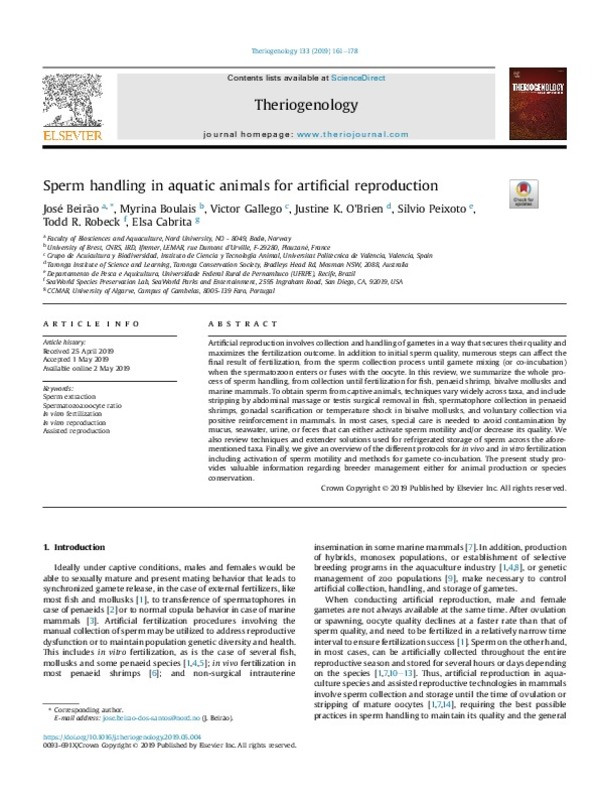JavaScript is disabled for your browser. Some features of this site may not work without it.
Buscar en RiuNet
Listar
Mi cuenta
Estadísticas
Ayuda RiuNet
Admin. UPV
Sperm handling in aquatic animals for artificial reproduction
Mostrar el registro sencillo del ítem
Ficheros en el ítem
| dc.contributor.author | Beirao, Jose
|
es_ES |
| dc.contributor.author | Boulais, Myrina
|
es_ES |
| dc.contributor.author | Gallego Albiach, Victor
|
es_ES |
| dc.contributor.author | O'Brien, Justine K.
|
es_ES |
| dc.contributor.author | Peixoto, Silvio
|
es_ES |
| dc.contributor.author | Robeck, Todd R.
|
es_ES |
| dc.contributor.author | Cabrita, Elsa
|
es_ES |
| dc.date.accessioned | 2022-02-11T19:02:39Z | |
| dc.date.available | 2022-02-11T19:02:39Z | |
| dc.date.issued | 2019-07-15 | es_ES |
| dc.identifier.issn | 0093-691X | es_ES |
| dc.identifier.uri | http://hdl.handle.net/10251/180761 | |
| dc.description.abstract | [EN] Artificial reproduction involves collection and handling of gametes in a way that secures their quality and maximizes the fertilization outcome. In addition to initial sperm quality, numerous steps can affect the final result of fertilization, from the sperm collection process until gamete mixing (or co-incubation) when the spermatozoon enters or fuses with the oocyte. In this review, we summarize the whole process of sperm handling, from collection until fertilization for fish, penaeid shrimp, bivalve mollusks and marine mammals. To obtain sperm from captive animals, techniques vary widely across taxa, and include stripping by abdominal massage or testis surgical removal in fish, spermatophore collection in penaeid shrimps, gonadal scarification or temperature shock in bivalve mollusks, and voluntary collection via positive reinforcement in mammals. In most cases, special care is needed to avoid contamination by mucus, seawater, urine, or feces that can either activate sperm motility and/or decrease its quality. We also review techniques and extender solutions used for refrigerated storage of sperm across the afore-mentioned taxa. Finally, we give an overview of the different protocols for in vivo and in vitro fertilization including activation of sperm motility and methods for gamete co-incubation. The present study provides valuable information regarding breeder management either for animal production or species conservation. Crown Copyright (C) 2019 Published by Elsevier Inc. All rights reserved. | es_ES |
| dc.description.sponsorship | MB research was supported by CRB-anim (ANR-11-INBS-003) and Reproseed (FP7-KBBE-2009-3). VG has a postdoc grant from the MICIU (Juan de la Cierva-Incorporacion; IJCI-2017-34200). EC was supported by project ReproFl 16-02-01-FMP-59 financed by the MAR2020 Program and through the Fundacao para a Ciencia e Tecnologia (FCT, Portugal) through project FCT UID/Multi/04326/2019. This is the SeaWorld technical contribution number 2019-10. | es_ES |
| dc.language | Inglés | es_ES |
| dc.publisher | Elsevier | es_ES |
| dc.relation.ispartof | Theriogenology | es_ES |
| dc.rights | Reconocimiento (by) | es_ES |
| dc.subject | Sperm extraction | es_ES |
| dc.subject | Spermatozoa:oocyte ratio | es_ES |
| dc.subject | In vitro fertilization | es_ES |
| dc.subject | In vitro reproduction | es_ES |
| dc.subject | Assisted reproduction | es_ES |
| dc.subject.classification | PRODUCCION ANIMAL | es_ES |
| dc.title | Sperm handling in aquatic animals for artificial reproduction | es_ES |
| dc.type | Artículo | es_ES |
| dc.identifier.doi | 10.1016/j.theriogenology.2019.05.004 | es_ES |
| dc.relation.projectID | info:eu-repo/grantAgreement/EC/FP7/245119/EU/ | es_ES |
| dc.relation.projectID | info:eu-repo/grantAgreement/FCT//UID%2FMulti%2F04326%2F2019/ | es_ES |
| dc.relation.projectID | info:eu-repo/grantAgreement/MCIU//IJCI-2017-34200//Ayuda Juan de la Cierva Incorporación - Gallego Albiach/ | es_ES |
| dc.relation.projectID | info:eu-repo/grantAgreement/EMFF//ReproF1 16-02-01-FMP-59//MAR2020/ | es_ES |
| dc.relation.projectID | info:eu-repo/grantAgreement/CRB-anim//ANR-11-INBS-003/ | es_ES |
| dc.rights.accessRights | Abierto | es_ES |
| dc.contributor.affiliation | Universitat Politècnica de València. Departamento de Ciencia Animal - Departament de Ciència Animal | es_ES |
| dc.description.bibliographicCitation | Beirao, J.; Boulais, M.; Gallego Albiach, V.; O'brien, JK.; Peixoto, S.; Robeck, TR.; Cabrita, E. (2019). Sperm handling in aquatic animals for artificial reproduction. Theriogenology. 133:161-178. https://doi.org/10.1016/j.theriogenology.2019.05.004 | es_ES |
| dc.description.accrualMethod | S | es_ES |
| dc.relation.publisherversion | https://doi.org/10.1016/j.theriogenology.2019.05.004 | es_ES |
| dc.description.upvformatpinicio | 161 | es_ES |
| dc.description.upvformatpfin | 178 | es_ES |
| dc.type.version | info:eu-repo/semantics/publishedVersion | es_ES |
| dc.description.volume | 133 | es_ES |
| dc.identifier.pmid | 31108371 | es_ES |
| dc.relation.pasarela | S\407729 | es_ES |
| dc.contributor.funder | CRB-anim | es_ES |
| dc.contributor.funder | European Commission | es_ES |
| dc.contributor.funder | European Maritime and Fisheries Fund | es_ES |
| dc.contributor.funder | Ministerio de Ciencia, Innovación y Universidades | es_ES |
| dc.contributor.funder | Fundação para a Ciência e a Tecnologia, Portugal | es_ES |








